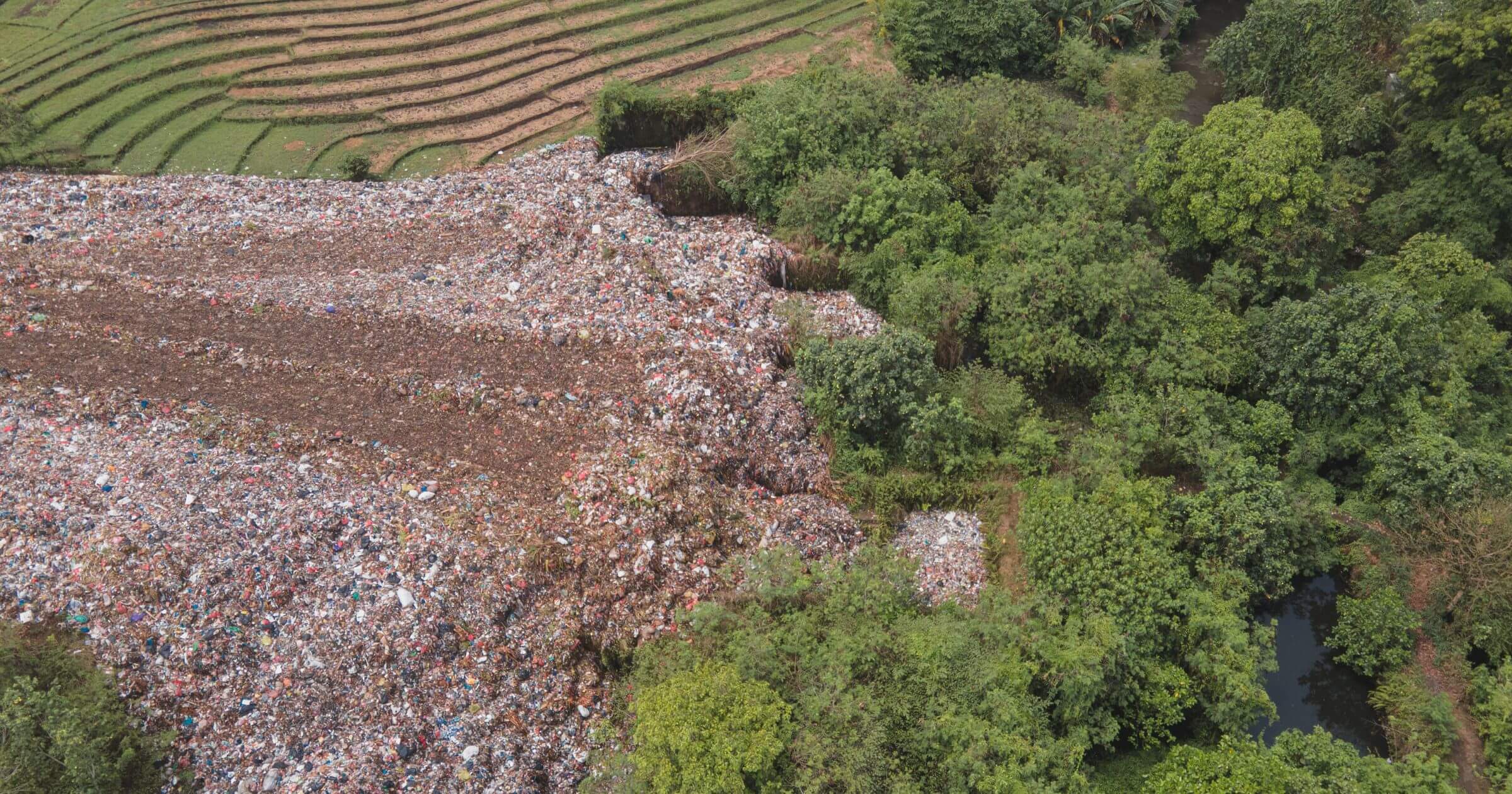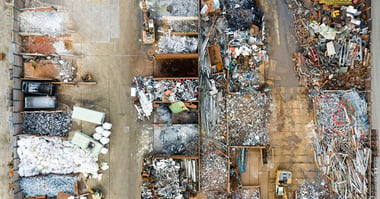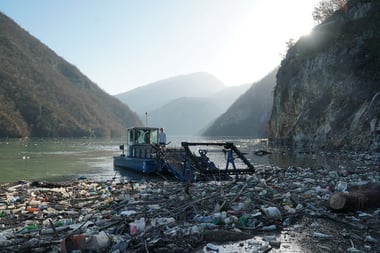At CleanHub, it’s our mission to make sure no plastic ends up in our oceans.
So far, we’ve collected over 15,500,00 kilograms (kg) of plastic — primarily through household waste collections — and we plan on building on this success in the coming years.
Unlike many other waste collection services around the world, we collect non-recyclable materials as well as recyclable ones, which are usually discarded or burned in many countries.
This often raises one key question: What do we do with the waste once it's collected? Well, the recyclable items are sent to a local recycling plant to be fed back into the circular economy, and the non-recyclable items are turned into alternative fuel.
It’s a complex process — but don’t worry, we’ll explain everything you need to know in this article, including how it works, what other options are out there, and why landfill simply isn’t an option for us.
What’s on this page?
01 | Our impact02 | Understanding the plastic we work with
03 | What we do with the plastic waste we collect
04 | Why choose plastic as an alternative fuel?
05 | What we do with the fuel created from co-processing
06 | Other solutions we’re considering
07 | Why landfill disposal is not an option for us
08| FAQs
Our impact
At CleanHub, we want a world free of plastic pollution — and we’re making this happen by collecting all kinds of waste from coastal communities, preventing it from being openly burnt, dumped, and reaching waterways.
So, how much waste have we collected so far? Let’s break it down.
As of May 2025, we’ve collected 15,743,533 kilograms (kg) of waste — all financed by our amazing brand partners. That’s the same weight as 525 humpback whales!
This is mainly made up of plastics but also contains paper, cardboard, and wet waste.
Our collection hubs estimate that roughly 30% of the waste we collect and sort is recyclable plastic, which is then sold into the recycling process.
To make sure our projects have additionality — meaning they wouldn’t have happened without our financial support — we focus on incentivizing and paying for non-recyclable waste. This non-recyclable certified waste, is then measured as ‘net-dry’ plastic waste where the moisture contents are deducted from the final weight.
On top of this, one of our key goals is to bring more transparency to the waste industry, which is why we also partner with waste managers beyond plastic credits, inviting them to use our technology to track collections and manage their operations.
Understanding the plastic we collect
Before we dive into the ins and outs of our process, let’s introduce you to the material we work with. Although we also collect recyclable materials, all plastic credits purchased through CleanHub also pay for the collection of non-recyclable and negative-value plastic.
We also focus our recovery efforts on this material because it’s estimated that roughly 80% of all plastic that enters the oceans is multi-layer or flexible plastics — which aren’t recyclable, as there currently lacks the infrastructure to repurpose them.
By collecting this waste, we’re helping local communities, wildlife, and the environment from being smothered in plastic. This is especially true in the regions we work in, including Indonesia, India, and Tanzania, where they lack in waste management infrastructure.
What we do with the plastic waste we collect
The recyclable items that we collect are sent to a local recycling facility, where they can be processed and fed back into the circular economy.
Since we can’t do this with non-recyclable material, we send these items to a co-processing plant — a facility that uses combustion to transform waste products into energy and raw materials.
Co-processing plants do this by burning plastic waste in a cement kiln at incredibly high temperatures, between 2,800 ºF and 2,550 ºF (1,250 ºC and 1,450 ºC). This allows the waste to burn quickly, taking an average of 4-5 seconds to fully combust.
Although this method can't be considered as a 'green' process, because it still generates emissions, it can help certain industries reduce their reliance on raw materials or virgin fossil fuels.
What’s the difference between co-processing and incineration?
The key difference between co-processing and incineration is that one utilizes leftover energy sources, while the other doesn’t.
The main goal of incineration is to eradicate the volume of waste products by burning them into ash without really considering sustainability. The bottom ashes from incineration also tend to end up in landfill.
Co-processing is considered the more sustainable option because it uses the waste for another purpose. During co-processing, waste generates heat and minerals that benefit industrial practices. When products are completely burned, the byproducts are re-used in cement mixtures.
The heat in the cement kiln is also considerably higher than in it is a standard incinerator, so if run right, the process shouldn't release toxins and furans (toxic chemicals).
Why choose co-processing for plastic waste?
Co-processing is one of the few solutions we have when dealing with non-recyclable materials.
Despite reducing some industries' carbon footprints, we wouldn't class co-processing as environmentally friendly — after all, it still generates emissions. But we see it as a short-term solution for a long-term challenge: the lesser of evils, but not a process we'd want to rely on forever.
Why co-processing is a good option for non-recyclable plastics (until we find a greener solution):
- Reduces emissions in certain industries — A recent study found that the co-processing method can reduce 53 kg of carbon dioxide (CO2) per ton of cement produced, while also extending the expiration date for landfills by 7.55 years. However, the overall environmental impact of co-processing depends on the specific technology used, the type of plastic feedstock, and the energy efficiency of the conversion process
- Provides economic benefits — The European Union suggests that investing in co-processing will avoid about €12 billion of public funds to dedicated waste incineration plants. This method is also estimated to be about five to ten times cheaper than conventional forms of incineration
- Safe and clean process — Compared to other incineration methods, co-processing is a clean and safe process. The temperature profiles are constantly monitored and managed to avoid the formation of dioxins and furans (toxic compounds that can be harmful to human health)
- Avoids using raw materials — By using the co-processing method, we can utilize existing resources, reduce our dependence on raw materials, and move towards a more circular economy
Despite these benefits, we won’t call this a green technology, since plastic is made from oil — but it’s the best available option we have globally to reduce plastic pollution and avoid dumping more waste in landfills.
As soon as we see a way to treat non-recyclable waste in a greener way, we’ll make the switch.
What we do with the energy created from co-processing
The energy that’s generated from the plastic we collect goes towards the cement industry — yes, the cement industry that's responsible for 7-8% of global carbon emissions.
The reason? Well, cement makers around the world have pledged to cut their greenhouse gas emissions by up to a quarter by 2030 — and we want to help them get there. Not only will this benefit the cement industry, but it will also reduce global emissions.
This industry is notoriously difficult to make greener for two key reasons:
- It needs temperatures of between 2,280 ºF and 3,630 ºF (1,250 °C–2,000 °C) to melt the limestone it works with. This process is responsible for around 50% of the cement industry’s carbon emissions
- These extreme temperatures can only currently be achieved by burning fossil fuels, such as coal and lignite, which are responsible for around 40% of a cement plant’s carbon emissions. The other 10% comes from sourcing raw materials
By switching from carbon-intensive raw materials to fuel created by co-processing, we can help cement producers reduce 53 kg of carbon dioxide (CO2) per ton of cement produced.
It’s not a silver bullet, but it’s certainly a step in the right direction. And with new solar technology emerging, there’s hope that this polluting industry will one day be fully renewable.

Other solutions we’re considering
We want to make sure we’re using the best methods possible for both the planet and local communities.
That means we’re constantly on the lookout for other ways to utilize non-recyclable plastic waste, whilst also considering existing infrastructure.
Here are the main two options we’re keeping our eye on.
Chemical recycling
This process involves changing the chemical structure of a waste item, and turning it back into substances that can be used as raw materials for the manufacturing of plastics or other products.
We’re continuing to observe developments in the chemical recycling industry. However, most of the solutions in the field still focus on turning plastic into fuels, such as diesel or kerosene. We’re hoping this approach will one day be able to turn old plastic back into a usable plastic product again.
And as chemical recycling is a very energy-intensive process, it’s more environmentally friendly to stick with the co-processing route — for now.
Using plastics as construction material
We’re also keeping an eye on developments in how experts are integrating plastics into construction materials, such as pavement tiles or bricks.
Although we applaud the innovative thinking behind this, we’re skeptical about this solution for two key reasons:
- At the moment, it’s unclear whether the plastic integrated into these structures will release harmful chemicals inside the building
- These materials still won’t be recyclable at the end of their lifecycle, and will likely end up in landfill once the structure deteriorates
Why landfill disposal is not an option for us
Landfills are not a sustainable solution to the plastic waste crisis.
These trash-filled areas aim to reduce the amount of waste that makes it into the open environment, prevent disease transmission, and keep communities clean. However, the more we continue to rely on landfills, the worse-off our planet will become.
In fact, without the right environmental protection, landfills leak a huge amount of waste into nature. This is the prime reason why we need non-recyclable waste to be co-processed, rather than sent to landfill.
Here are a handful of other reasons why landfills are simply not an option for us.
Increased emissions
As organic mass in a landfill begins to decompose, it releases methane gas — a greenhouse gas that is 80 times more harmful to the planet than CO2, making it one of the main contributors to climate change.
Evidence also suggests that once plastic is exposed to UV light, it begins emitting greenhouse gasses like methane and ethylene, and this process doesn’t ever stop.
If landfills are not covered, the plastics sitting there will continue emitting these gasses — and if they are covered, they still run the risk of leaking chemicals into the soil.
Health risks to locals
The leachate (harmful fluid created from the trash) trickles into the groundwater and poisons it with heavy metals and other pollutants. This means people who live near landfills have a higher risk of developing certain health problems.
For example, a study in New York found that children born to families that lived within a mile of a hazardous waste landfill site have a 12% increased risk of congenital malformations (birth defects).
On top of this, minority and low-income areas are more likely to find themselves living next to landfills and hazardous waste sites.
Harmful for wildlife
Natural habitats and wild spaces are often destroyed to make way for new landfill sites. And since the average landfill site takes up around 600 acres, they disturb a lot of wildlife.
As well as destroying habitats to make room for landfills, the sites themselves also have a detrimental impact on any animals in the area. Leaked leachate will often contaminate nearby water sources, which can cause severe health implications — or even death — when consumed by animals.
Spontaneous fires
It’s not uncommon for landfills to spontaneously break out into fires, which can happen on both a surface level and an underground level — with the latter being much more challenging to put out.
An increase in the oxygen content of the landfill is the most common cause of underground landfill fires, as it increases bacterial activity and raises temperatures. These hot spots can then come into contact with pockets of methane gas and result in a fire.
Summary
When it comes to the plastic waste crisis, innovation needs to happen both upstream and downstream — in the packaging industry but also in the waste management industry.
As well as reducing the amount of plastic we consume as a society, we need to clean up the mess we’ve already created around the world.
One of the key ways we can do that is by continuing to build a vast network of waste collection projects — and that’s exactly what we’re doing at CleanHub.
Want to work together to reduce plastic pollution in vulnerable areas? Find out what else we have to offer brands on our page: The Benefits of Partnering with CleanHub.
FAQs
How does CleanHub collect plastic?
The majority of our plastic recovery efforts come from household collection. However, we also explore other methods, including beach cleanups, utilizing existing systems, empowering micro-entrepreneurs, and investing in collection technology in rivers.
You can learn more about this on our page: How Does CleanHub Collect Plastic Waste?
What does CleanHub do with the recyclable waste that is collected?
Although we focus our efforts on collecting non-recyclable waste, we sometimes carry out projects that branch out to recyclable waste too, such as beach cleanups.
In these situations, we allow the hubs that we partner with to sell the material, and they get to keep the profits.
How does CleanHub track its plastic collection?
Our tracking process will change slightly, depending on the collection methods used. When it comes to household collection, our crew scans a QR code on the door, which opens our app and registers their specific location.
Once the homeowner hands over the waste, the collectors put it on a small scale and a crew member takes a picture. Along with the bag’s image, we resolved the geo-location to make sure the waste was collected where it was supposed to be collected.
The crew also registers the weight displayed on the scale, and we cross-check these values.
You can learn more about this process, and what happens after, on our page: How Does CleanHub’s Tracking Software Work?

.webp)
-3.png)


.webp?width=380&name=Someone-recycling-waste%20(1).webp)
.webp?width=380&name=Recycling-plant%20(1).webp)
.webp?width=380&name=landfill%20(2).webp)
.png?width=380&name=CleanHub%20Bcorp%20(1).png)
.webp?width=380&name=wave%20(1).webp)

.webp?width=380&name=CleanHub-collectors-%20(1).webp)
.webp?width=380&name=warehouse%20(1).webp)
